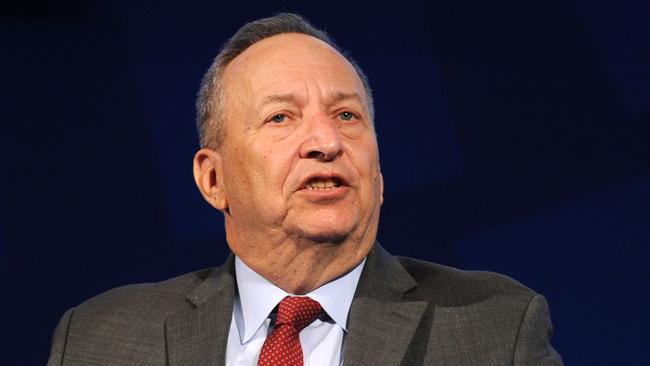As a perfect policy storm brews, risk of inflation could rise
Economies are roaring back to life, but more spending could mean higher prices, putting pressure on interest rates.

To be sure, asset prices soared, supercharging wealth inequality, but growth of consumer prices never picked up. Headline inflation figures repeatedly fell short of central bank targets in Australia, Europe and the US. Is this time different? Even Larry Summers, Bill Clinton’s Treasury secretary, has urged the Biden administration to think twice before launching a $US4 trillion ($5.1 trillion) spending spree.
All the reasons put forward in late 2008 to predict inflation then loom far larger now: government debt and deficits have risen higher and more sharply, and central banks have created new money on a scale that dwarfs their efforts during the GFC. The Federal Reserve is buying $US120 billion worth of bonds every month with new money. About 90 per cent of the debt issued by the British government during the past year has been bought by the Bank of England with newly created money.
If Milton Friedman’s famous dictum – that inflation is always and everywhere a monetary phenomenon – holds any water, surely now is its time to shine. In the 1960s Friedman and colleague Anna Schwartz illustrated a relationship between inflation and money sloshing around.
M3, the broadest measure of an economy’s money supply, has leapt 28 per cent in the US in only 13 months to March, to almost $US19.9 trillion, according to the Federal Reserve Bank of St Louis – the most rapid ascent ever. In 2009 the same measure rose 6 per cent to $US8.5 trillion.
It’s not only monetary factors that point to higher inflation but also a perfect storm of policies and geopolitical realities. Lifting government-imposed restrictions on supply as the pandemic fades will lead to a surge in spending that could push up prices.
If governments are serious about slashing emissions by 2030, they will need to radically restructure their energy supply. High carbon taxes, de facto or otherwise, will push up energy prices drastically, causing a ripple effect. The cost of building and maintaining enough batteries to prevent blackouts will increase as more reliable and often cheaper coal, gas and nuclear power stations are switched off.
The steady deflationary effects of China’s entrance into the global trading system, providing increasingly advanced consumer goods at lower prices, are petering out. In the event of a military confrontation they would peter out even more quickly.
There’s another difference with 2009: higher inflation has already emerged, in the US at least. Prices are up 4.2 per cent during the 12 months to April, the highest reading since 2008. In March and April prices rose a combined 1.7 per cent, almost the Federal Reserve’s target for a whole year.
Whether you’re on the left, right, monetarist or Keynesian, there’s a reason to think higher inflation is on the horizon. Growing interest in crypto currencies and the frenzy to buy real estate throughout the developed world must reflect, to some extent, declining trust in fiat currencies.
The Biden administration and the Federal Reserve have been at pains to argue the spike in inflation is transitory. (Governments everywhere probably hope it’s not, given inflation can help them whittle away enormous public debts.) They could be right. The unravelling of supply bottlenecks as restrictions lift inevitably will lead to price jumps here and there. Meanwhile, Japan serves as a reminder that vast public debts funded by central bank money creation don’t automatically create inflation. The Bank of Japan has repeatedly missed its 2 per cent inflation target.
And people aren’t spending money as frequently, which puts downward pressure on inflation.
But what matters is whether households and businesses start to expect rising prices, which then feed into wages, causing a damaging wage-price spiral where no one wins. Inflation is an expectations game.
No one born after 1975 has anything but theoretical appreciation of higher inflation, so expectations may take longer to update. But governments shouldn’t be blase. Inflation became an economic bogeyman for good reasons: it undermines genuine commerce and hurts lower-income workers who tend to save in bank deposits. And rising prices will make for angry voters, especially when wages are unlikely to keep pace.
That jobless rates are still higher than they were pre-pandemic, giving government room to stimulate further without stoking inflation, should be cold comfort. The 1970s showed unemployment and inflation can be high at the same time.
Vaccines are all the stimulus economies need now. Economies are roaring back to life as restrictions end, giving households a bigger array of goods and services on which they can spend their bolstered pandemic savings.
The biggest risk from inflation is the parallel increase in interest rates and the inevitable slump in asset values. Mechanically, asset prices will fall by a much larger percentage when interest rates are increasing from lower levels. With interest rates near zero, even a two percentage point increase in lending rates could wreak havoc on the value of shares and real estate.
Central banks ratcheted up interest rates in the late 80s to choke inflation. They can’t do the same this time. Government finances, not to mention those of many households, wouldn’t be sustainable at higher interest rates. That could spell runaway inflation if the public loses confidence in the willingness of central banks or their ability to meet their inflation targets. However independent they seem, central banks exist to serve governments.




A lot of analysts ended up with egg on their faces following the global financial crisis. The rampant inflation many feared as the world’s central banks cranked up their quantitative easing programs, mopping up government bonds with trillions of dollars, euros and yen of newly created money, never eventuated.